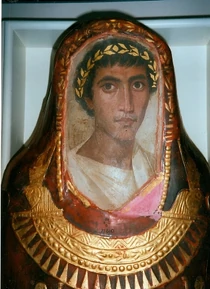The sarcophagus is marked; 'Farewell, Artemidorus', a translation of the Greek inscription along with a portrait of a young man's face, preserve the identity of the 18-21 year old. The mummy case is dated to be around AD 100-120, in the Roman period, and was discovered by Flinders Petrie in Hawara, Egypt.
Mummification[]
A clash of cultural influences is shown through the mummification of Artemidorus with use of a Roman type portrait, the inscription of his Greek name, along with traditional Egyptian mummification and art styles on the casing.

Studies[]
Maintaining the seal sarcophagus, CT scans were performed on the mummy revealing evidence of damage to the bones around the nose and back of the head. Artemidorus was believed to be around 20 years of age upon death, which is also represented through the portrait of a young looking man.
Pathology[]
The damage to the head shows no sign of healing, indicating that it occurred around the time of death or was the cause of death. This reveals the possibility that some form of physical trauma such a assault or accident led to death, however, it could also be the result of damaging mummification practices.
Additional[]
Designs were painted on the wood with the use of a wax pigment, as well as egg to harden it. The Egyptian style art scenes were created using gold leaf.
References[]
Cormack, R. (2007). Icons. Cambridge, Massachusette: Harvard University Press.
R Mazza (2013, May 9). Life and Death in Roman Egypt: Artemidoros and his family [Web log post]. Retrieved from https://facesandvoices.wordpress.com/2013/05/09/life-and-death-in-roman-egypt-artemidoros-and-his-family/
Jones, J. (2001, November 24). Artemidorus (100-120). The Guardian. Retrieved from http://www.theguardian.com/culture/2001/nov/24/art
